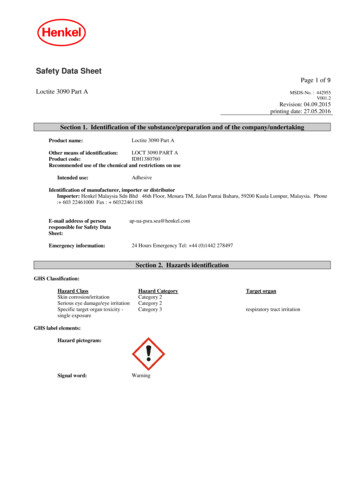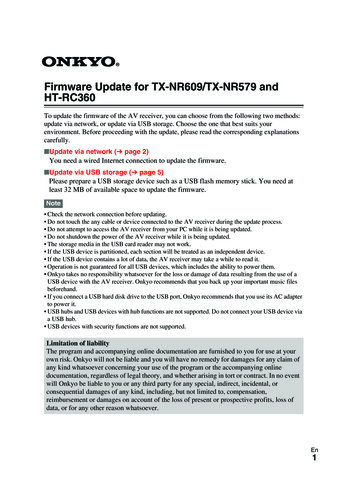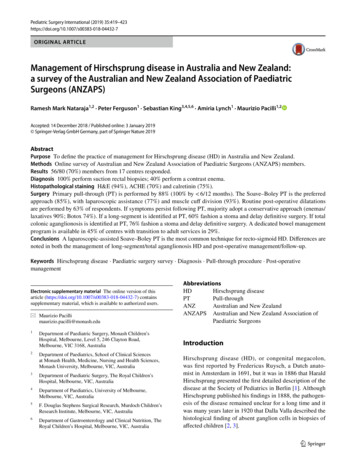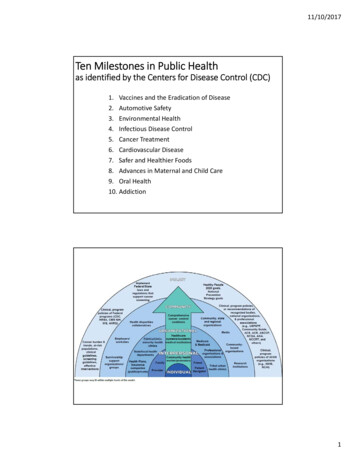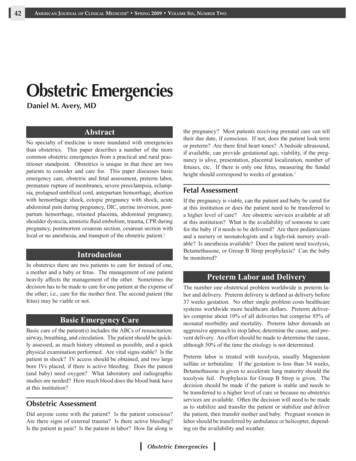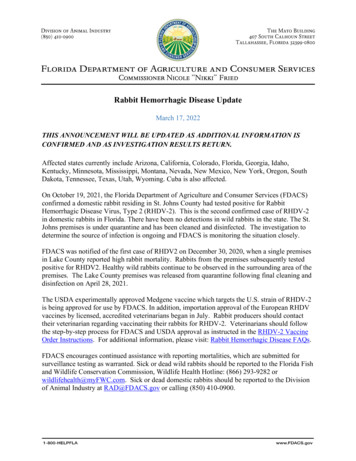
Transcription
Rabbit Hemorrhagic Disease UpdateMarch 17, 2022THIS ANNOUNCEMENT WILL BE UPDATED AS ADDITIONAL INFORMATION ISCONFIRMED AND AS INVESTIGATION RESULTS RETURN.Affected states currently include Arizona, California, Colorado, Florida, Georgia, Idaho,Kentucky, Minnesota, Mississippi, Montana, Nevada, New Mexico, New York, Oregon, SouthDakota, Tennessee, Texas, Utah, Wyoming. Cuba is also affected.On October 19, 2021, the Florida Department of Agriculture and Consumer Services (FDACS)confirmed a domestic rabbit residing in St. Johns County had tested positive for RabbitHemorrhagic Disease Virus, Type 2 (RHDV-2). This is the second confirmed case of RHDV-2in domestic rabbits in Florida. There have been no detections in wild rabbits in the state. The St.Johns premises is under quarantine and has been cleaned and disinfected. The investigation todetermine the source of infection is ongoing and FDACS is monitoring the situation closely.FDACS was notified of the first case of RHDV2 on December 30, 2020, when a single premisesin Lake County reported high rabbit mortality. Rabbits from the premises subsequently testedpositive for RHDV2. Healthy wild rabbits continue to be observed in the surrounding area of thepremises. The Lake County premises was released from quarantine following final cleaning anddisinfection on April 28, 2021.The USDA experimentally approved Medgene vaccine which targets the U.S. strain of RHDV-2is being approved for use by FDACS. In addition, importation approval of the European RHDVvaccines by licensed, accredited veterinarians began in July. Rabbit producers should contacttheir veterinarian regarding vaccinating their rabbits for RHDV-2. Veterinarians should followthe step-by-step process for FDACS and USDA approval as instructed in the RHDV-2 VaccineOrder Instructions. For additional information, please visit: Rabbit Hemorrhagic Disease FAQs.FDACS encourages continued assistance with reporting mortalities, which are submitted forsurveillance testing as warranted. Sick or dead wild rabbits should be reported to the Florida Fishand Wildlife Conservation Commission, Wildlife Health Hotline: (866) 293-9282 orwildlifehealth@myFWC.com. Sick or dead domestic rabbits should be reported to the Divisionof Animal Industry at RAD@FDACS.gov or calling (850) 410-0900.
Rabbit Hemorrhagic Disease and New Emergency Rule for Importation of RabbitsFor a map of affected states visit the USDA website lhealth/SA-Epidemiology-AnimalHealthCEAH/Risk Identification.Summary of RHDV-2 TestingCountyDomestic Rabbits– NegativeLakex (feral)St. JohnsLeeManatee(3)Palm CollierAlachuaxSarasotax (feral)OsceolaMartinCharlotteWild Rabbits– NegativeDomestic Rabbits– Positivex (12/30/2020)x (10/18/2021)Wild Rabbits– Positive10xx82(2)xxxxThere is currently no evidence that the virus has spread to domestic or wild rabbits from theDecember detection in Lake County nor from the October detection in St. Johns County. Rabbitowners should continue to take prudent biosecurity measures, including not purchasing hay orother commodities originating in RHDV-2 affected states.Genetic sequencing of the RHDV-2 from the Lake County case in Florida indicates this virusmatches those identified in rabbits in the Southwest United States.RHDV is an extremely contagious and often fatal viral disease of domesticated and wild rabbits.There are three forms of the RHDV virus. RHDV-2 is believed to infect all ages of domesticrabbits but less deadly than types RHDV and RHDVa. RHDV-2 is both stable and infectious inthe environment for long periods of time, potentially surviving more than 3 months without ahost.RHDV-2 remains classified as a foreign animal disease. Therefore, suspect RHDV-2 should bereported to the Division of Animal Industry at RAD@FDACS.gov or calling (850) 410-0900.Testing rabbits is key to monitoring the disease spread. RHDV-2 has been observed as highmortality events in multiple species of wild (free-ranging) rabbits in the affected states as well.Wild rabbits introduced into domestic populations have also served as a disease source to thePage 2 of 5
Rabbit Hemorrhagic Disease and New Emergency Rule for Importation of Rabbitsdomestic rabbits. Sick wild rabbits should not be introduced to a premises with domestic rabbits.Sick or dead wild rabbits should be reported to the Florida Fish and Wildlife ConservationCommission, Wildlife Health Hotline: (866) 293-9282.The first sign of infection with RHDV is often sudden and unexpected death in previouslyhealthy rabbits. Those that do not die immediately may demonstrate poor appetite, depression,inactivity, and listlessness; they will have a fever and bloody nasal discharge may be noted.Later signs relate to organ failure and include jaundice, respiratory distress, diarrhea, weight loss,bloating, and death. Rabbits surviving infection are believed to shed the virus for at least 30days, but in experimental cases, they shed the virus for up to 105 days. Long term/permanentshedding is unlikely. Exposed and surviving rabbits have immunity to that viral strain for anunknown amount of time. All rabbits imported into Florida from a non-RHDV affected state are required to have anOfficial Certificate of Veterinary Inspection (OCVI) dated within 30 days of entry (seeAnimal Movement Page, ck/AnimalMovement)ALL SUSCEPTIBLE ANIMALS IMPORTED FROM A RHDV AFFECTED STATEMUST HAVE AN OCVI DATED WITHIN 72 HOURS OF ENTRY AND AVETERINARY STATEMENTo Florida Administrative Code, 5C-3 effective January 31, 2021o apter 5C-35C-3.015 Rabbits.(1) All Lagomorphs originating from a state that has had RHD diagnosed in wild or domesticanimals in the past twenty-four (24) months, are required to be accompanied by an OfficialCertificate of Veterinary Inspection. The OCVI must include the statement in subsection 5C3.015(2), F.A.C. and be signed and dated by the examining veterinarian within seventy-two (72)hours prior to entry into Florida.(2) The OCVI must include the following statement from the examining veterinarian, “Allanimals on this shipment have not been exposed to a known or suspected case of RHD and showno clinical signs of diseases on the inspection date of (inspection/examination date).”Rulemaking Authority 570.07(21), (23), 585.08(2)(a) FS. Law Implemented 585.08(1), 585.145FS. History–New 1-31-21.Biosecurity is the key to prevention of RHDV: Keep a closed rabbitry. Exclude wild and feral rabbits from the rabbitry. Wash your hands between handling rabbits in different pens. Control flies and biting insects. Clean and disinfect equipment, tools, footwear, feed and water containers, and cages.Recommended disinfectants include those in the phenol class or 10 percent bleach. Cleanthoroughly with soap and water first and apply disinfectant for recommended contacttime. Rinse well and allow to dry before allowing animal contact. House rabbits indoors if possible.Page 3 of 5
Rabbit Hemorrhagic Disease and New Emergency Rule for Importation of Rabbits Do not share equipment with others who raise rabbits.Contact your veterinarian if sick or dead rabbits are observed and submit carcasses forexamination and prompt sampling.Do not transport rabbits into or out of RHDV quarantine areas.Separate new rabbits or those returning from shows for one month.Additional disease resources:Iowa State t hemorrhagic disease.pdfNational Wildlife Health Center - cdisease-virus-2-confirmed-wild-rabbits-usUSDA – alth/sa-epidemiologyanimalhealth-ceah/ri https://www.aphis.usda.gov/publications/animal health/fs-rhdv2.pdf. h/rhdEPA (Information on disinfectant products) -virus-rhdv2OIE – Immediate Notification – RHDV Cuba https://wahis.oie.int/#/report-info?reportId 34994Status/Situational Reports from RHDV2 Affected States:Arizona - lifornia - https://www.cdfa.ca.gov/AHFSS/Animal Health/Pets Other UnReg Species.html#rhdColorado - abbit-hemorrhagic-diseasevirus-rhdv2Georgia - Rabbit Hemorrhagic Disease Virus Update - Ga Dept of Agriculture(georgia.gov)Idaho - orrhagic-diseaseMinnesota - RHDV2 Confirmed in Minnesota - Sept. 28 - RHDV2.orgMississippi http://www.mbah.ms.gov/rabbithem/index.html? ga 492Page 4 of 5
Rabbit Hemorrhagic Disease and New Emergency Rule for Importation of RabbitsMontana - ease-reported-inyellowstone-countyNew Mexico - -disease-cause-forrabbit-mortality/New York- State Agriculture Department Confirms Case of Rabbit Hemorrhagic Disease Virus 2in New York Agriculture and Markets (ny.gov)Oregon - lDiseases/RHDV.aspxSouth Dakota - https://aib.sd.gov/RHDV2.htmlTennessee - it-disease-confirmed-intennessee.htmlTexas Animal Health Commission - https://www.tahc.texas.gov/animal health/rabbits/Utah - on State- ePage 5 of 5
Oct 19, 2021 · mortality events in multiple species of wild (free-ranging) rabbits in the affected states as well. Wild rabbits introduced into domestic populations have also served as a disease source to the domestic rabbits. Sick wild rabbits shou


